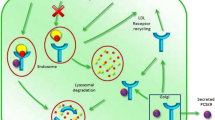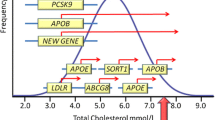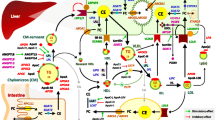Abstract
Familial combined hyperlipidemia (FCHL) is one of the most common familial lipoprotein disorders of the lipoproteins, with a prevalence of 0.5% to 2% in different populations. About 10% of these patients suffer from cardiovascular disease and this number is increased by up to 11.3% in the young survivors of myocardial infarction and by 40% among all the survivors of myocardial infarction. Although initially thought to be that FCHL has an inheritance pattern of monogenic, the disease’s etiology is still not fully understood and it appears that FCHL has a complex pattern related to genetic variants, environmental factors, and lifestyles. Two strategies have been used to identify its complex genetic background: candidate gene and the linkage approach, which have yielded an extensive list of genes associated with FCHL with a variable degree of scientific evidence. Until now, more than 30 different genetic variants have been identified related to FCHL. In this study, we aimed to review the individual genes that have been described in FCHL and how these genes and variants can be related to the current concept of metabolic pathways resulting in familial combined hyperlipidemia.

Similar content being viewed by others
References
Aguilar-Salinas CA, Tusie-Luna T, Pajukanta P (2014) Genetic and environmental determinants of the susceptibility of Amerindian derived populations for having hypertriglyceridemia. Metabolism 63(7):887–894
Beeks E, Janssen RG, Kroon AA, Keulen ET, Geurts JM, De Leeuw PW et al (2001) Association between the α-adducin Gly460Trp polymorphism and systolic blood pressure in familial combined hyperlipidemia. Am J Hypertens 14(12):1185–1190
Brouwers MC, Van Greevenbroek MM, Stehouwer CD, De Graaf J, Stalenhoef AF (2012) The genetics of familial combined hyperlipidaemia. Nat Rev Endocrinol 8(6):352
Brouwers MCGJ, van Greevenbroek MMJ, Stehouwer CDA, de Graaf J, Stalenhoef AFH (2012) The genetics of familial combined hyperlipidaemia. Nat Rev Endocrinol 8:352
Brouwers MC, de Graaf J, Simons N, Meex S, ten Doeschate S, van Heertum S et al (2020) Incidence of type 2 diabetes in familial combined hyperlipidemia. BMJ Open Diabetes Res Care 8(1):e001107
Civeira F, Jarauta E, Cenarro A, García-Otín AL, Tejedor D, Zambón D et al (2008) Frequency of low-density lipoprotein receptor gene mutations in patients with a clinical diagnosis of familial combined hyperlipidemia in a clinical setting. J Am Coll Cardiol 52(19):1546–1553
Dawson MI, Xia Z (2012) The retinoid X receptors and their ligands. Biochim Biophys Acta (BBA)-Mole Cell Biol Lipids 1821(1):21–56
De Castro-Orós I, Civeira F, Pueyo MJ, Mateo-Gallego R, Bolado-Carrancio A, Lamíquiz-Moneo I et al (2016) Rare genetic variants with large effect on triglycerides in subjects with a clinical diagnosis of familial vs nonfamilial hypertriglyceridemia. J Clin Lipidol 10(4):790–797
Demirkan A, van Duijn CM, Ugocsai P, Isaacs A, Pramstaller PP, Liebisch G et al (2012) Genome-wide association study identifies novel loci associated with circulating phospho-and sphingolipid concentrations. PLoS Genetics 8(2):e1002490
Dennedy MC, Vidal-Puig A (2014) An adipocentric view of the metabolic syndrome and cardiovascular disease. Curr Cardiovasc Risk Rep 8(3):379
Di Taranto MD, Staiano A, D’Agostino MN, D’Angelo A, Bloise E, Morgante A et al (2015) Association of USF1 and APOA5 polymorphisms with familial combined hyperlipidemia in an Italian population. Mol Cell Probes 29(1):19–24
Domínguez-Reyes T, Astudillo-López CC, Salgado-Goytia L, Muñoz-Valle JF, Salgado-Bernabé AB, Guzmán-Guzmán IP et al (2015) Interaction of dietary fat intake with APOA2, APOA5 and LEPR polymorphisms and its relationship with obesity and dyslipidemia in young subjects. Lipids Health Dis 14(1):106
Ellis KL, Pang J, Chan DC, Hooper AJ, Bell DA, Burnett JR et al (2016) Familial combined hyperlipidemia and hyperlipoprotein(a) as phenotypic mimics of familial hypercholesterolemia: frequencies, associations and predictions. J Clin Lipidol 10(6):1329–37.e3
Engelbrechtsen L, Hansen T, Mahendran Y, Pyl P, Andersson E, Jonsson A et al (2017) Homozygous carriers of the TCF7L2 rs7903146 T-allele show altered postprandial response in triglycerides and triglyceride-rich lipoproteins. Sci Rep 7:43128
Farbstein D, Soloveichik YZ, Levy NS, Levy AP (2011) Genetics of redox systems and their relationship with cardiovascular disease. Curr Atheroscler Rep 13(3):215–224
Farhan SMK, Robinson JF, McIntyre AD, Marrosu MG, Ticca AF, Loddo S et al (2014) A novel LIPE nonsense mutation found using exome sequencing in siblings with late-onset familial partial lipodystrophy. Can J Cardiol 30(12):1649–1654
Gaddi A, Cicero A, Odoo F (2007) Practical guidelines for familial combined hyperlipidemia diagnosis: an up-date. Vasc Health Risk Manag 3(6):877
Gallardo-Blanco HL, Villarreal-Perez JZ, Cerda-Flores RM, Figueroa A, Sanchez-Dominguez CN, Gutierrez-Valverde JM et al (2017) Genetic variants in KCNJ11, TCF7L2 and HNF4A are associated with type 2 diabetes, BMI and dyslipidemia in families of Northeastern Mexico: a pilot study. Exp Ther Med 13(2):523–529
Garcia CK, Mues G, Liao Y, Hyatt T, Patil N, Cohen JC et al (2001) Sequence diversity in genes of lipid metabolism. Genome Res 11(6):1043–1052
Gw Go, Srivastava R, Hernandez-Ono A, Gang G, Smith SB, Booth CJ et al (2014) The combined hyperlipidemia caused by impaired Wnt-LRP6 signaling is reversed by Wnt3a rescue. Cell Metab 19(2):209–220
Horra A, Salazar J, Ferré R, Vallvé J-C, Guardiola M, Rosales R et al (2009) Prox-1 and FOXC2 gene expression in adipose tissue: a potential contributory role of the lymphatic system to familial combined hyperlipidaemia. Atherosclerosis 206(2):343–345
Huertas-Vazquez A, Plaisier CL, Geng R, Haas BE, Lee J, Greevenbroek MM et al (2010) A nonsynonymous SNP within PCDH15 is associated with lipid traits in familial combined hyperlipidemia. Hum Genet 127(1):83
Janssen MC, Van Engelen B, Kapusta L, Lammens M, Van Dijk M, Fischer J et al (2013) Symptomatic lipid storage in carriers for the PNPLA2 gene. Eur J Hum Genet 21(8):807
Jiang Z, Tian Y, Shan D, Wang Y, Gerhard E, Xia J et al (2018) pH protective Y1 receptor ligand functionalized antiphagocytosis BPLP-WPU micelles for enhanced tumor imaging and therapy with prolonged survival time. Biomaterials 170:70–81
Johansen CT, Kathiresan S, Hegele RA (2011) Genetic determinants of plasma triglycerides. J Lipid Res 52(2):189–206
Kathiresan S, Willer CJ, Peloso GM, Demissie S, Musunuru K, Schadt EE et al (2009) Common variants at 30 loci contribute to polygenic dyslipidemia. Nat Genet 41(1):56
Leduc V, Bourque L, Poirier J, Dufour R (2016) Role of rs3846662 and HMGCR alternative splicing in statin efficacy and baseline lipid levels in familial hypercholesterolemia. Pharmacogenet Genomics 26(1):1
Lee JC, Weissglas-Volkov D, Kyttälä M, Dastani Z, Cantor RM, Sobel EM et al (2008) WW-domain-containing oxidoreductase is associated with low plasma HDL-C levels. Am J Hum Genet 83(2):180–192
Liu Z-K, Hu M, Baum L, Thomas GN, Tomlinson B (2010) Associations of polymorphisms in the apolipoprotein A1/C3/A4/A5 gene cluster with familial combined hyperlipidaemia in Hong Kong Chinese. Atherosclerosis 208(2):427–432
López-Ruiz A, Jarabo MM, Martínez-Triguero ML, Morales-Suárez-Varela M, Solá E, Bañuls C et al (2009) Small and dense LDL in familial combined hyperlipidemia and N291S polymorphism of the lipoprotein lipase gene. Lipids Health Dis 8(1):12
Luijten J, van Greevenbroek MM, Schaper NC, Meex SJ, van der Steen C, Meijer LJ et al (2019) Incidence of cardiovascular disease in familial combined hyperlipidemia: a 15-year follow-up study. Atherosclerosis 280:1–6
Luo X, Yu C, Fu C, Shi W, Wang X, Zeng C et al (2015) Identification of the differentially expressed genes associated with familial combined hyperlipidemia using bioinformatics analysis. Mol Med Rep 11(6):4032–4038
Mabuchi H, Nohara A, Inazu A (2014) Cholesteryl ester transfer protein (CETP) deficiency and CETP inhibitors. Mol Cells 37(11):777
Manolescu BN, Busu C, Badita D, Stanculescu R, Berteanu M (2015) Paraoxonase 1–an update of the antioxidant properties of high-density lipoproteins. Maedica 10(2):173
Marcil M, Vu H, Cui W, Dastani Z, Engert JC, Gaudet D et al (2006) Identification of a novel C5L2 variant (S323I) in a French Canadian family with familial combined hyperlipemia. Arterioscler Thromb Vasc Biol 26(7):1619–1625
Mar-Heyming R, Miyazaki M, Weissglas-Volkov D, Kolaitis NA, Sadaat N, Plaisier C et al (2008) Association of stearoyl-CoA desaturase 1 activity with familial combined hyperlipidemia. Arterioscler Thromb Vasc Biol 28(6):1193–1199
Meex SJ, Weissglas-Volkov D, van der Kallen CJ, Thuerauf DJ, van Greevenbroek MM, Schalkwijk CG et al (2009) The ATF6-Met [67] Val substitution is associated with increased plasma cholesterol levels. Arterioscler Thromb Vasc Biol 29(9):1322–1327
Minicocci I, Prisco C, Montali A, Di Costanzo A, Ceci F, Pigna G et al (2015) Contribution of mutations in low density lipoprotein receptor (LDLR) and lipoprotein lipase (LPL) genes to familial combined hyperlipidemia (FCHL): a reappraisal by using a resequencing approach. Atherosclerosis 242(2):618–624
Mirdamadi HZ, Sztanek F, Derdak Z, Seres I, Harangi M, Paragh G (2008) The human paraoxonase-1 phenotype modifies the effect of statins on paraoxonase activity and lipid parameters. Br J Clin Pharmacol 66(3):366–374
Mullen TD, Hannun YA, Obeid LM (2012) Ceramide synthases at the centre of sphingolipid metabolism and biology. Biochemical Journal 441(3):789–802
Naukkarinen J, Ehnholm C, Peltonen L (2006) Genetics of familial combined hyperlipidemia. Curr Opin Lipidol 17(3):285–290
Pajukanta P, Allayee H, Krass KL, Kuraishy A, Soro A, Lilja HE et al (2003) Combined analysis of genome scans of Dutch and Finnish families reveals a susceptibility locus for high-density lipoprotein cholesterol on chromosome 16q. Am J Hum Genet 72(4):903–917
Pajukanta P, Lilja HE, Sinsheimer JS, Cantor RM, Lusis AJ, Gentile M et al (2004) Familial combined hyperlipidemia is associated with upstream transcription factor 1 (USF1). Nat Genet 36(4):371–376
Paththinige C, Sirisena N, Dissanayake V (2017) Genetic determinants of inherited susceptibility to hypercholesterolemia–a comprehensive literature review. Lipids Health Dis 16(1):103
Patni N, Ahmad Z, Wilson DP (2000) Genetics and dyslipidemia. MDText.com, Inc., South Dartmouth, MA
Perttilä J, Merikanto K, Naukkarinen J, Surakka I, Martin NW, Tanhuanpää K et al (2009) OSBPL10, a novel candidate gene for high triglyceride trait in dyslipidemic Finnish subjects, regulates cellular lipid metabolism. J Mol Med 87(8):825–835
Plaisier CL, Horvath S, Huertas-Vazquez A, Cruz-Bautista I, Herrera MF, Tusie-Luna T et al (2009) A systems genetics approach implicates USF1, FADS3, and other causal candidate genes for familial combined hyperlipidemia. PLoS Genet 5(9):e1000642
Plaisier CL, Kyttälä M, Weissglas-Volkov D, Sinsheimer JS, Huertas-Vazquez A, Riba L et al (2009) Galanin preproprotein is associated with elevated plasma triglycerides. Arterioscler Thromb Vasc Biol 29(1):147–152
Poursharifi P, Rezvani R, Gupta A, Lapointe M, Marceau P, Tchernof A et al (2014) Association of immune and metabolic receptors C5aR and C5L2 with adiposity in women. Med Inflamm 2014:1–10
Ramasamy I (2016) Update on the molecular biology of dyslipidemias. Clin Chim Acta 454:143–185
Ribalta J, Figuera L, Fernández-Ballart J, Vilella E, Castro Cabezas M, Masana L et al (2002) Newly identified apolipoprotein AV gene predisposes to high plasma triglycerides in familial combined hyperlipidemia. Clin Chem 48(9):1597–1600
Ripatti P, Rämö JT, Söderlund S, Surakka I, Matikainen N, Pirinen M et al (2016) The contribution of GWAS loci in familial dyslipidemias. PLoS Genet 12(5):e1006078
Roy C, Gupta A, Fisette A, Lapointe M, Poursharifi P, Richard D et al (2013) C5a receptor deficiency alters energy utilization and fat storage. PLoS ONE 8(5):e62531
Saarela JS, Pajukanta P, Lilja HE, Sinsheimer JS, Cantor RM, Lusis AJ, Gentile M, Duan XJ, Soro-Paavonen A, Naukkarinen J, Saarela J, Laakso M, Ehnholm C, Taskinen MR, Peltonen L (2004) Familial combined hyperlipidemia is associated with upstream transcription factor 1 (USF1). Nat Genet 36:371–376
Sáez ME, González-Pérez A, Martínez-Larrad MT, Gayán J, Real LM, Serrano-Ríos M et al (2010) WWOX gene is associated with HDL cholesterol and triglyceride levels. BMC Med Genet 11(1):148
Sathiyakumar V, Kapoor K, Jones SR, Banach M, Martin SS, Toth PP (2018) Novel therapeutic targets for managing dyslipidemia. Trends Pharmacol Sci 39(8):733–747
Savel J, Lafitte M, Pucheu Y, Pradeau V, Tabarin A, Couffinhal T (2012) Very low levels of HDL cholesterol and atherosclerosis, a variable relationship–a review of LCAT deficiency. Vasc Health Risk Manag 8:357
Sentinelli F, Minicocci I, Montali A, Nanni L, Romeo S, Incani M et al (2013) Association of RXR-gamma gene variants with familial combined hyperlipidemia: genotype and haplotype analysis. J Lipids 2013:1–7
Smathers RL, Petersen DR (2011) The human fatty acid-binding protein family: evolutionary divergences and functions. Hum Genomics 5(3):170
Solanas-Barca M, de Castro-Orós I, Mateo-Gallego R, Cofán M, Plana N, Puzo J et al (2012) Apolipoprotein E gene mutations in subjects with mixed hyperlipidemia and a clinical diagnosis of familial combined hyperlipidemia. Atherosclerosis 222(2):449–455
Tabassum R, Mahajan A, Chauhan G, Dwivedi OP, Dubey H, Sharma V et al (2011) No association of TNFRSF1B variants with type 2 diabetes in Indians of Indo-European origin. BMC Med Genet 12(1):110
Taghizadeh E, Esfehani RJ, Sahebkar A, Parizadeh SM, Rostami D, Mirinezhad M et al (2019) Familial combined hyperlipidemia: an overview of the underlying molecular mechanisms and therapeutic strategies. IUBMB Life 71(9):1221–1229
Taghizadeh E, Mardani R, Rostami D, Taghizadeh H, Bazireh H, Hayat SMG (2019) Molecular mechanisms, prevalence, and molecular methods for familial combined hyperlipidemia disease: a review. J Cell Biochem 120(6):8891–8898
Taghizadeh E, Ghayour-Mobarhan M, Ferns GA, Pasdar A (2020) A novel variant in LPL gene is associated with familial combined hyperlipidemia. BioFactors 46(1):94–99
Talmud PJ, Futema M, Humphries SE (2014) The genetic architecture of the familial hyperlipidaemia syndromes: rare mutations and common variants in multiple genes. Curr Opin Lipidol 25(4):274–281
Weissglas-Volkov D, Plaisier CL, Huertas-Vazquez A, Cruz-Bautista I, Riano-Barros D, Herrera-Hernandez M et al (2010) Identification of two common variants contributing to serum apolipoprotein B levels in Mexicans. Arterioscler Thromb Vasc Biol 30(2):353–359
Wiesbauer F, Blessberger H, Azar D, Goliasch G, Wagner O, Gerhold L et al (2009) Familial-combined hyperlipidaemia in very young myocardial infarction survivors (≤ 40 years of age). Eur Heart J 30(9):1073–1079
Wijsman EM, Rothstein JH, Igo RP, Brunzell JD, Motulsky AG, Jarvik GP (2010) Linkage and association analyses identify a candidate region for apoB level on chromosome 4q32.3 in FCHL families. Hum Genet 127(6):705–19
Zhu J, Manichaikul A, Hu Y, Chen Y-DI, Liang S, Steffen LM et al (2017) Meta-analysis of genome-wide association studies identifies three novel loci for saturated fatty acids in East Asians. Eur J Nutr 56(4):1477–84
Acknowledgements
The authors would like to thank all colleagues in the Department of Biotechnology, Faculty of Medicine, Mashhad University of Medical Sciences. I deeply appreciate and thank Darioush Rostami for assistance in this research.
Funding
This research received no specific Grant from any funding agency in the public, commercial, or not-for-profit sectors.
Author information
Authors and Affiliations
Contributions
All authors listed have made a substantial, direct, and intellectual contribution to the work and approved it for publication.
Corresponding author
Ethics declarations
Conflict of interest
The authors declare no conflict of interests.
Additional information
Publisher's Note
Springer Nature remains neutral with regard to jurisdictional claims in published maps and institutional affiliations.
Rights and permissions
About this article
Cite this article
Taghizadeh, E., Farahani, N., Mardani, R. et al. Genetics of Familial Combined Hyperlipidemia (FCHL) Disorder: An Update. Biochem Genet 60, 453–481 (2022). https://doi.org/10.1007/s10528-021-10130-2
Received:
Accepted:
Published:
Issue Date:
DOI: https://doi.org/10.1007/s10528-021-10130-2




